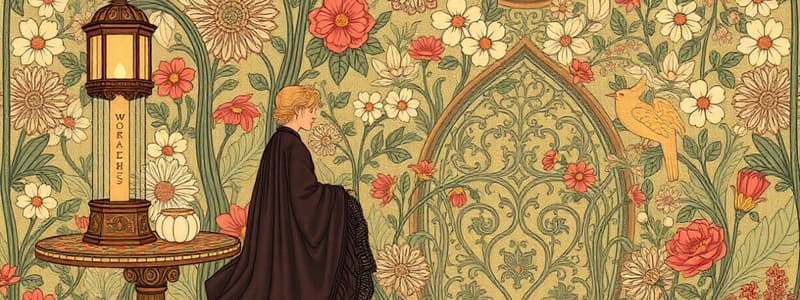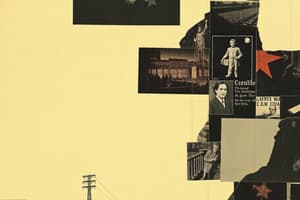Podcast
Questions and Answers
What is a key characteristic of a short story?
What is a key characteristic of a short story?
- Often includes a large number of characters
- Can support multiple plot lines
- Focus on one subject (correct)
- Usually divided into chapters
Which of the following best describes a realistic novel?
Which of the following best describes a realistic novel?
- Includes magical elements and fantastical creatures
- Rooted in social class and plausible experiences (correct)
- Contains historical events and figures
- Characters interact in implausible scenarios
What defines a historical novel?
What defines a historical novel?
- It is set in the author's lifetime
- It is set in a period earlier than that of the writing (correct)
- It incorporates elements of horror and mystery
- It focuses primarily on modern settings
Which novel is an example of an autobiographical novel?
Which novel is an example of an autobiographical novel?
What is the primary focus of a gothic novel?
What is the primary focus of a gothic novel?
An allegorical novel typically has which of the following characteristics?
An allegorical novel typically has which of the following characteristics?
What is a common trait of a novella?
What is a common trait of a novella?
Which author is known for writing a notable short story?
Which author is known for writing a notable short story?
What is the significance of the setting in 'Animal Farm'?
What is the significance of the setting in 'Animal Farm'?
Which character is referred to as Old Major?
Which character is referred to as Old Major?
What narrative technique is primarily used in the beginning of 'Animal Farm'?
What narrative technique is primarily used in the beginning of 'Animal Farm'?
What is the primary conflict introduced in the early chapters of 'Animal Farm'?
What is the primary conflict introduced in the early chapters of 'Animal Farm'?
How does the writing style in 'Animal Farm' impact the reader's understanding?
How does the writing style in 'Animal Farm' impact the reader's understanding?
Which theme is likely to be emphasized throughout 'Animal Farm'?
Which theme is likely to be emphasized throughout 'Animal Farm'?
What event prompts the animals to gather in the barn in 'Animal Farm'?
What event prompts the animals to gather in the barn in 'Animal Farm'?
What does the character Mr. Jones exemplify in the context of the story?
What does the character Mr. Jones exemplify in the context of the story?
Flashcards
Narrator
Narrator
The person or entity narrating the story, determining the perspective and information shared with the reader.
Characters
Characters
The main individuals in a story, driving the plot and experiencing its events. Often, they represent important ideas or themes.
Short Story
Short Story
A type of fiction that tells a complete story in a few thousand words, usually between 3000 to 5000 words. It typically features one plot-line, a limited number of characters, limited settings, and focuses on a single subject.
Events and Interactions
Events and Interactions
Signup and view all the flashcards
Novella
Novella
Signup and view all the flashcards
Setting
Setting
Signup and view all the flashcards
Novel
Novel
Signup and view all the flashcards
Writing Style
Writing Style
Signup and view all the flashcards
Realistic Novel
Realistic Novel
Signup and view all the flashcards
Theme
Theme
Signup and view all the flashcards
Historical Novel
Historical Novel
Signup and view all the flashcards
Conflict
Conflict
Signup and view all the flashcards
Gothic Novel
Gothic Novel
Signup and view all the flashcards
Resolution
Resolution
Signup and view all the flashcards
Autobiographical Novel
Autobiographical Novel
Signup and view all the flashcards
Allegorical Novel
Allegorical Novel
Signup and view all the flashcards
Study Notes
Fiction Types
- Fiction encompasses various forms, including short stories and novels.
- Short stories are typically 3,000 to 5,000 words, focusing on one plotline, limited characters, and settings, centering on one subject.
- Famous short story writers include Edgar Allan Poe, Anton Chekhov, and Ernest Hemingway.
Novellas
- Novellas sit between short stories and full-length novels, ranging from 10,000 to 40,000 words.
- They typically follow one plotline, although they aren't always divided into chapters.
Novels
- Novels are considered a relatively modern literary form.
- They often feature multiple, interconnected plotlines that may contrast with one another.
- Novels often encompass diverse settings and portray multiple characters and their individual stories.
- They are typically organized into chapters.
- The publication of Robinson Crusoe in 1719 marked a significant milestone in the development of the novel.
Realistic Novels
- Realistic novels aim to portray reality through depictions of complex characters driven by mixed motives with social class backgrounds.
- These characters navigate social structures, interact plausibly, and experience everyday events.
- Examples include Thirteen Reasons Why by Jay Asher and Looking for Alaska by John Green.
Historical Novels
- Historical novels are set in periods preceding the writing's time.
- Notable examples include Thackeray's Vanity Fair and Charles Dickens's A Tale of Two Cities.
Gothic Novels
- Gothic novels feature elements of terror, mystery, horror, supernatural themes, and often include settings evocative of doom, death, decay, and haunted buildings.
- Classic examples include Mary Shelley's Frankenstein and John William Polidori's The Vampyre.
Autobiographical Novels
- Autobiographical novels are rooted in the author's own life experiences.
- Examples include Charles Dickens' David Copperfield and D. H. Lawrence's Sons and Lovers.
Allegorical Novels
- Allegories use storytelling to convey deeper meanings, often with symbolic representations of political, religious, historical, or philosophical concepts.
- Animal Farm by George Orwell and The Lord of the Flies by William Golding are examples.
Analyzing Novels
- Understanding the implicit meaning in a novel goes beyond explicit statements.
- Essential elements for analysis include identifying:
- Characters and their roles
- The narrator
- Events and interactions throughout the plot
- The conflict and its resolution
Elements of Novel Analysis
- Setting: The location of the story, crucial for understanding the background, context, and information surrounding the narrative. Consider whether the setting is a significant aspect of the plot, supplying particular information or historical context.
- Writing Style: The author's method of writing, including detail, impact, and potential gaps that require interpretation. Consider if the writing style affects the meaning or forces the reader to make assumptions about missing information.
- Themes: Repeated or emphasized ideas, characters, and events that the author uses across the novel to convey an underlying message.
Animal Farm (Chapters 1-2) Summary
- Animal Farm, by George Orwell (1903-1950), starts with Mr. Jones, the farmer, being inebriated and ignoring the farm animals.
- Animals gather to discuss old Major's dream, leading to a plot about revolution against mistreatment by humankind.
Studying That Suits You
Use AI to generate personalized quizzes and flashcards to suit your learning preferences.




